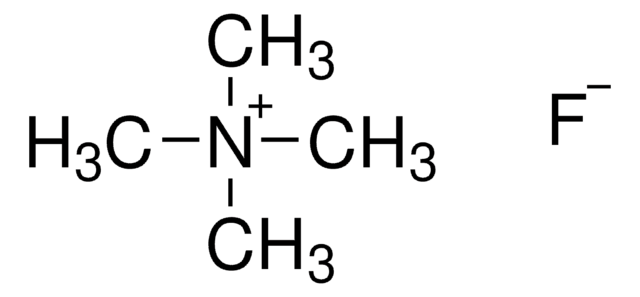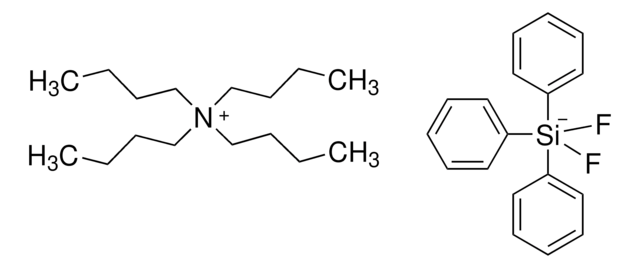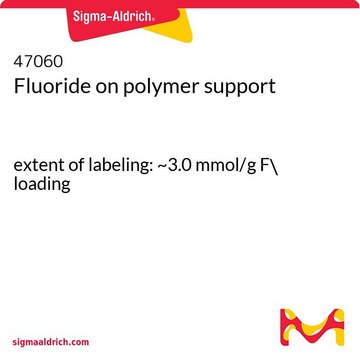241512
Tetrabutylammonium fluoride hydrate
98%
Synonym(s):
TBAF
Sign Into View Organizational & Contract Pricing
All Photos(3)
About This Item
Linear Formula:
[CH3(CH2)3]4NF·xH2O
CAS Number:
Molecular Weight:
261.46 (anhydrous basis)
MDL number:
UNSPSC Code:
12352116
PubChem Substance ID:
NACRES:
NA.22
Recommended Products
Quality Level
assay
98%
form
solid
mp
62-63 °C (lit.)
functional group
amine
SMILES string
O.[F-].CCCC[N+](CCCC)(CCCC)CCCC
InChI
1S/C16H36N.FH.H2O/c1-5-9-13-17(14-10-6-2,15-11-7-3)16-12-8-4;;/h5-16H2,1-4H3;1H;1H2/q+1;;/p-1
InChI key
UQCWXKSHRQJGPH-UHFFFAOYSA-M
General description
Tetrabutylammonium fluoride hydrate is known to be a source of F− anion, used in nucleophilic fluorination reactions.
Application
Reactant for preparation of:
- Double clathrate hydrates at high pressures
- Cellulose ethers
- Terminal olefins via dehydrohalogenation reactions
- Neutral and zwitterionic 3-carboranyl thymidine analogues for boron neutron capture therapy
Tetrabutylammonium fluoride hydrate can be used:
- To prepare 2,7-diethynyl-9-propyl-9H-carbazole, which is a key intermediate for the synthesis of calix[4]arene−carbazole polymers.
- As an anion source in the study of selective detection of F− by anion receptor viz Schiff base.
- To prepare terminal olefins from primary alkyl iodides
signalword
Danger
hcodes
Hazard Classifications
Eye Dam. 1 - Skin Corr. 1B
Storage Class
8A - Combustible corrosive hazardous materials
wgk_germany
WGK 3
flash_point_f
Not applicable
flash_point_c
Not applicable
ppe
Eyeshields, Faceshields, Gloves, type P3 (EN 143) respirator cartridges
Choose from one of the most recent versions:
Already Own This Product?
Find documentation for the products that you have recently purchased in the Document Library.
Customers Also Viewed
Naked-eye detection of F- and AcO- ions by Schiff base receptor
Dalapati S, et al.
Journal of Fluorine Chemistry, 132(8), 536-540 (2011)
Synthesis, 3085-3085 (2006)
Calix [4] arene-carbazole-containing polymers: Synthesis and properties
Barata PD, et al.
Reactive and Functional Polymers, 72(9), 627-634 (2012)
Hydrated tetrabutylammonium fluoride as a powerful nucleophilic fluorinating agent
Albanese D, et al.
The Journal of Organic Chemistry, 63(25), 9587-9589 (1998)
Sílvia Santos Pedrosa et al.
Macromolecular bioscience, 16(11), 1610-1620 (2016-07-28)
Hyaluronic acid nanogel (HyA-AT) is a redox sensitive crosslinkable nanogel, obtained through the conjugation of a thiolated hydrophobic molecule to the hyaluronic acid chain. Engineered nanogel was studied for its biocompatibility, including immunocompatibility and hemocompatability. The nanogel did not compromise
Our team of scientists has experience in all areas of research including Life Science, Material Science, Chemical Synthesis, Chromatography, Analytical and many others.
Contact Technical Service









